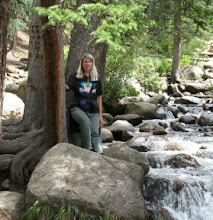 First it was "John Parmalee," who came to Colorado from Iowa in 1860, after news of the gold strikes reached him as it did so many others. Portraying Parmalee, John Steinle, from Hiwan Homestead Museum, reminded us that the impetus to leave homes in the east was not just the lure of gold, but also a result of the financial crisis precipitated by bank failures in 1857.
First it was "John Parmalee," who came to Colorado from Iowa in 1860, after news of the gold strikes reached him as it did so many others. Portraying Parmalee, John Steinle, from Hiwan Homestead Museum, reminded us that the impetus to leave homes in the east was not just the lure of gold, but also a result of the financial crisis precipitated by bank failures in 1857.Then it was my turn, as Maggie Maple Crow... in the early 1890s, Maggie and husband Will moved to Creede. In 1891, Creede had 10,000 people, most trying to make a living mining silver. Maggie and Will, accompanied by tiny daughter Dora, sewed tents for miners to live in, a profitable enterprise after fire in June 1892 destroyed many of Creede's more durable buildings. Creede was a wild town, with about a killing a day, Maggie later said. "One day as I left the tent with my little girl, Dora, a miscarried shot whizzed straight through the tent. We barely missed the bullet."
 It was in Creede that Will Crow became acquainted with Bob Ford and did some carpentry work for him. In appreciation, Ford gave Will Crow the gun, a frontier model Colt 45, with which Ford had killed Jesse James in 1882. Ten years had passed, and Ford confided to Will that he was a little tired of killing; two weeks later Ford himself was killed by a member of the James gang. That's how Maggie tells the story. (She kept the gun, displaying it in a 1948 newspaper interview.)
It was in Creede that Will Crow became acquainted with Bob Ford and did some carpentry work for him. In appreciation, Ford gave Will Crow the gun, a frontier model Colt 45, with which Ford had killed Jesse James in 1882. Ten years had passed, and Ford confided to Will that he was a little tired of killing; two weeks later Ford himself was killed by a member of the James gang. That's how Maggie tells the story. (She kept the gun, displaying it in a 1948 newspaper interview.)In 1893, of course, history caught up with Creede and many other mining towns in Colorado when the Sherman Silver Purchase Act was repealed, and the bottom dropped out of the silver market. Almost overnight, Creede went from boom to bust as its people, including the Crow family, left in search of other lodes and means of survival. Maggie and Will ended up back home in Junction. Always looking for ways to sustain themselves and their growing family, they later worked in a lumber camp together.
The Roaring Twenties found Maggie, a widow, panning gold in Hall Valley with her sons while raising her grandchildren. (Dora had died in the influenza epidemic of 1918-19.) She panned out about $2-3 a day (not bad income in those days), with grandson Ray playing as a gold panner next to her. Prospecting also got her through next big Depression, in the 1930s, and supplemented her Old Age Pension ($24/month), which began arriving in 1935.
Read about Maggie's next 1890s adventure, in her own words, at HistoricMorrison.org.
——
Photo of history night courtesy Cheryl Touryan. Creede's population these days is about 377 people (per 2000 census).
More on: the Panic of 1857,
the Panic of 1893, and its causes;
Creede, the silver camp that wouldn't die,
and the Sherman Silver Purchase Act.

No comments:
Post a Comment